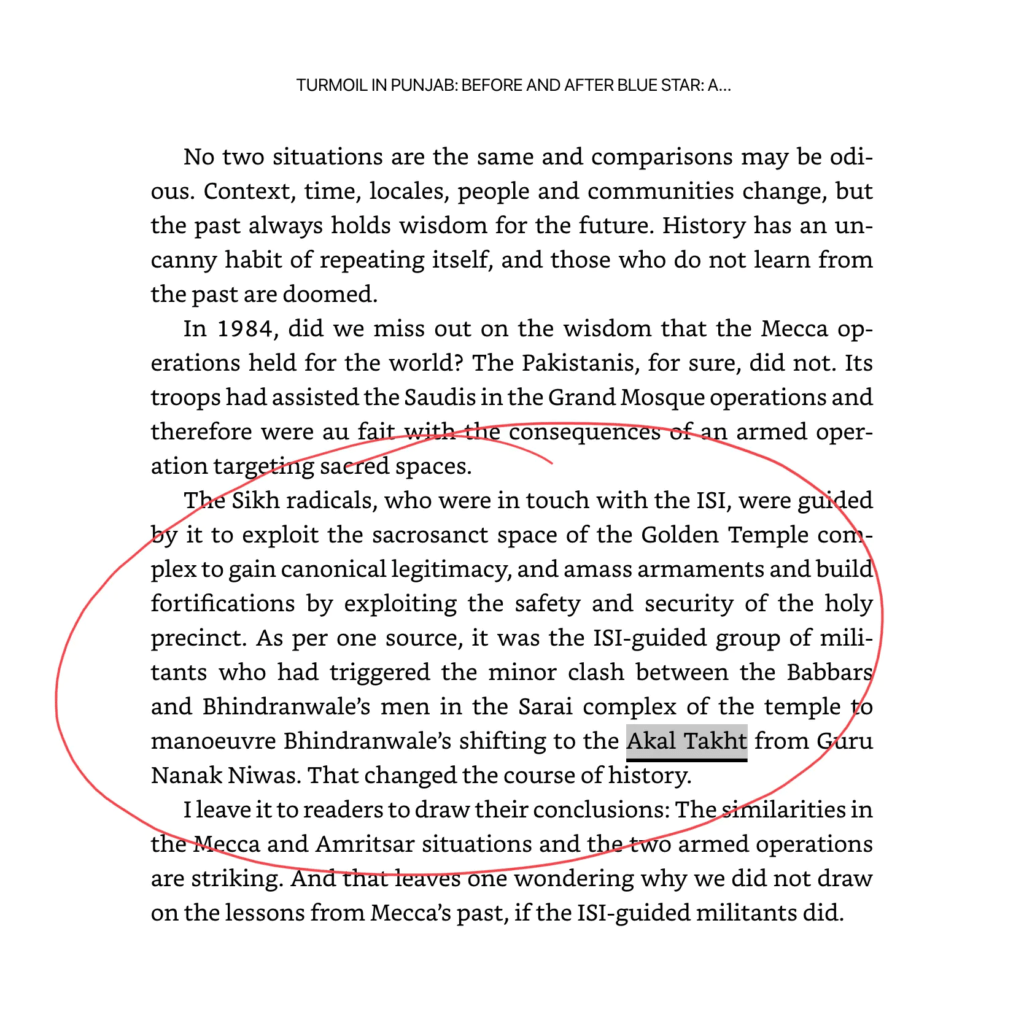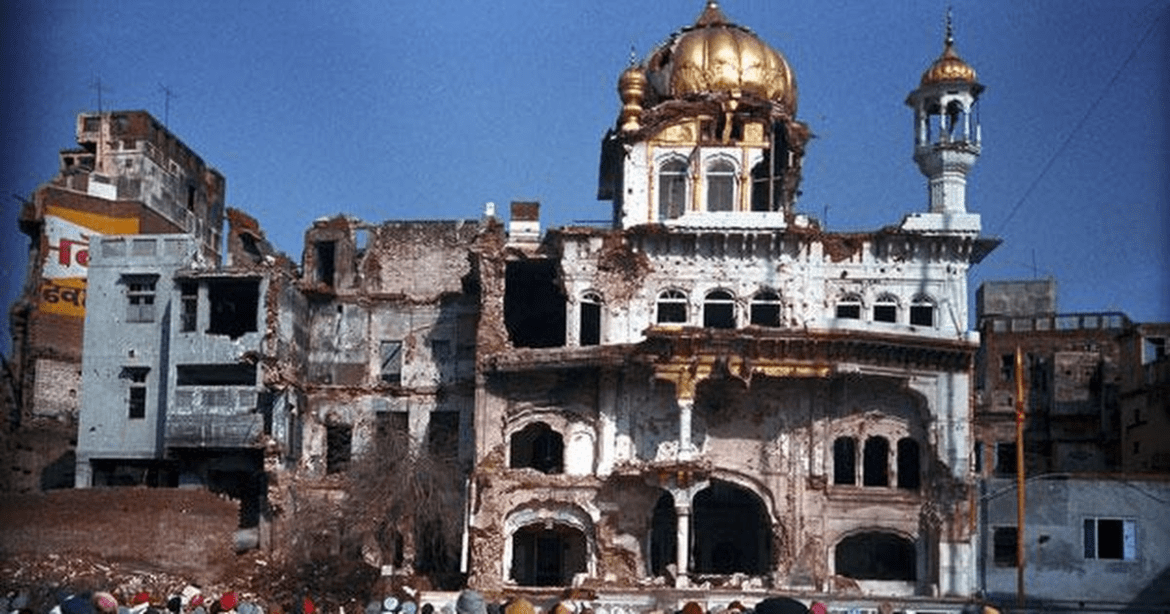AI Generated Summary
- In an interview, he unveiled that the situation leading to the attack on Harmandir Sahib was ignited by Sant Jarnail Singh Bhindranwale and his associates, including Shabeg Singh, a former Indian army officer turned military advisor to Bhindranwale, who essentially cornered the government of the time.
- His movements within the Golden Temple complex had far-reaching consequences, culminating in the devastating destruction of the Akal Takht, underscoring the intricate web of strategies and influences that shaped the course of Operation Blue Star.
- Operation Blue Star was a military operation carried out by the Indian Army in June 1984 to remove Sant Jarnail Singh Bhindranwale and his followers from the Harmandir Sahib Complex in Amritsar, Punjab.
As a Sikh, my soul often seems to be adrift in the tumultuous sea of history, trying to comprehend the shocking events surrounding Operation Blue Star that unfolded in 1984. The desecration of the Golden Temple, our spiritual beacon, indelibly scarred the nation. The violence and the defilement of our sacred place of worship undeniably marked a sorrowful episode in our collective narrative. Nonetheless, as I wade through this convoluted stream of our past, I am constantly confronted with a nagging question: what truths remain concealed behind the shroud of Operation Blue Star?
Operation Blue Star was a military operation carried out by the Indian Army in June 1984 to remove Sant Jarnail Singh Bhindranwale and his followers from the Harmandir Sahib Complex in Amritsar, Punjab. The operation resulted in heavy casualties and extensive damage to the Akal Takht, one of the holiest sites in Sikhism. While the official narrative often frames this operation as a necessary response to growing militancy, alternative perspectives complicate this view.
A perspective springs from the account of Hamid Gul, the former head of Pakistan’s Inter-Services Intelligence (ISI). In an interview, he unveiled that the situation leading to the attack on Harmandir Sahib was ignited by Sant Jarnail Singh Bhindranwale and his associates, including Shabeg Singh, a former Indian army officer turned military advisor to Bhindranwale, who essentially cornered the government of the time.
Shabeg Singh was accused by the army of corruption, with an inquiry subsequently launched to probe the charges. Some reports argue that Singh’s strategic guidance to Bhindranwale was a meticulously crafted revenge plot against the government that had accused him. However, even if we accept this perspective, it raises another pressing and perplexing question: how could a Sikh, regardless of his grievances, occupy the revered Golden Temple, a symbol of peace and spiritual solace, to settle personal scores?
Gul’s revelation paints a complex picture, forcing us to delve deeper into the circumstances leading up to Operation Blue Star. It nudges us to ponder over the possibility of external forces meticulously manipulating the events, thereby adding another layer to our understanding of this historical episode.
Not only were there weapons inside the Sikh holy shrine but all of the armed individuals were housed on the upper floor of Akal Takht. For any Sikh to stand above the Guru Granth Sahib was an act of absolute disregard. When 80-year-old Giani Pratap Singh, a former Jathedar of the Akal Takht, objected to occupying the Akal Takht, he was killed in cold blood. Others too were silenced.
In his book, Ramesh Inder Singh, a respected author, and former bureaucrat, also explores this notion. Singh argues that while local conditions and political factors played their part, the role of enemy nations exploiting these situations is undeniable. In his view, Pakistan capitalized on the unrest, supplying arms and training to exacerbate the turmoil.

Singh further draws a parallel to a similar operation conducted in Mecca a few years prior, where fundamentalists occupied the holy mosque. The Saudi Arabian army, with assistance from Pakistani and French commandos, reclaimed the religious site. According to Singh, Pakistan gleaned a crucial lesson from this operation: attacking a sacred religious space provokes an intense and wide-ranging reaction. Was the Golden Temple assault another manifestation of this lesson, applied strategically to inflame tensions in India?
Under what some suggest was the influence of Pakistan’s ISI, the intriguing maneuvers of Sant Jarnail Singh Bhindranwale within the Golden Temple complex add another layer of complexity to this narrative. Bhindranwale initially took up residence at Guru Nanak Niwas, an administrative section within the complex. His movements within the Golden Temple complex had far-reaching consequences, culminating in the devastating destruction of the Akal Takht, underscoring the intricate web of strategies and influences that shaped the course of Operation Blue Star.
If it was a war about the Sikhi, a question arises as to why the holy institutions were brought into the line of fire. While planning the operation, the army harbored a belief that the armed groups ensconced within the Golden Temple would not resist, and even if they did, their defense would crumble within a few hours. However, the fierce resistance encountered during the initial assault swiftly dispelled this notion. The army was taken aback by the readiness, strategic positioning, and training of the groups, which allowed them to put up a formidable defense. The high level of preparedness suggested that they had been trained by an experienced military strategist.
These narratives raise questions that are hard to ignore. Did external forces carefully orchestrate the circumstances leading up to Operation Blue Star, forcing the government’s hand? Was the ensuing turmoil part of a broader geopolitical strategy to stoke religious tensions within the country? While these questions don’t absolve the then government of its role in the operation, they compel us to consider the broader picture, painted in shades of grey rather than stark black and white.
The scars of Operation Blue Star are etched deep within the Sikh psyche and the collective memory of India. The events that unfolded were undoubtedly a dark chapter in our history, but the narrative is far from straightforward. It is a tale mired in political maneuvering, external influences, and strategic exploitation, the true depth of which we may never fully comprehend. However, as we continue to reflect on and learn from our history, it is crucial to remember that the story is never as simple as it seems.
Operation Blue Star’s legacy is a constant reminder of the fragility of peace and the ease with which external forces can exploit internal divisions. The operation was ostensibly aimed at eliminating a separatist threat, but the methods employed and the resultant destruction raised questions about the balance between national security and respect for religious sanctity. The government’s decision to storm the Golden Temple, especially on a significant religious date, further inflamed sentiments, leading to widespread outrage and violence that followed in its wake.
The ensuing pogroms against Sikhs, particularly in Delhi, added another layer of tragedy. Thousands of Sikhs were brutally murdered, their homes and businesses destroyed, in what can only be described as state-sponsored violence. The sense of injustice and betrayal felt by the Sikh community remains a festering wound, exacerbated by the lack of accountability and justice for the victims.
Reflecting on these events, it becomes clear that Operation Blue Star was not just a military operation but a pivotal moment that reshaped the socio-political landscape of India. The narratives surrounding it are diverse and often contradictory, each adding a piece to the puzzle of understanding this complex period. The involvement of foreign intelligence agencies, internal political dynamics, and the interplay of personal vendettas and larger geopolitical strategies all contributed to the unfolding drama.
As we sift through these layers, it becomes evident that history is not merely a record of events but a tapestry woven from the threads of multiple perspectives. Each thread represents a different viewpoint, and together they create a richer, albeit more complicated, picture. The challenge lies in acknowledging and understanding these diverse narratives without letting them polarize us further.
In examining Operation Blue Star, we must ask ourselves not only how these events transpired but also what lessons we can draw from them to prevent such tragedies in the future. How can we foster a society where differences are celebrated rather than exploited, where grievances are addressed through dialogue rather than violence? These are the questions that must guide our reflections and actions as we move forward.
The story of Operation Blue Star is a reminder of the importance of preserving our democratic values and the rule of law. It underscores the need for transparency, accountability, and a commitment to justice. It also highlights the critical role of historical memory in shaping our collective identity and guiding our future choices.
For the Sikh community, the pain of 1984 is a testament to resilience and faith. Despite the suffering, the community has continued to uphold the values of service, justice, and equality. The rebuilding of the Akal Takht stands as a symbol of this resilience, a reminder that while structures can be destroyed, the spirit of a people endures.
As a nation, we must honor this spirit by ensuring that such dark chapters are never repeated. This requires a collective commitment to understanding and addressing the root causes of conflict, promoting inclusivity, and upholding the sanctity of our religious and cultural heritage. Only by doing so can we hope to heal the wounds of the past and build a future founded on peace, justice, and mutual respect.
The enigma of Operation Blue Star invites us to engage in a deeper exploration of our history, to question the narratives we have inherited, and to seek a more nuanced understanding of the forces that shape our world. It is a call to remember that history is not just a series of events but a complex interplay of human actions and motivations. By embracing this complexity, we can begin to chart a path towards a more just and compassionate society, where the lessons of the past inform our efforts to build a better future for all.
The opinions expressed in this article are those of the author. They do not purport to reflect the opinions or views of Khalsa Vox or its members.




